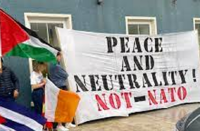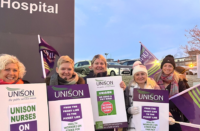On 3 May in this, the decade of anniversaries, we reached the hundredth anniversary of the partition of Ireland. Britain partitioned the country to protect its interests—not to protect us from each other but to keep us apart. Divide and conquer, imperialism’s favourite control mechanism, is a device they used everywhere they invade, occupy, and plunder. This article looks at how partition has worked in relation to the health service on both sides of the border.
The National Health Service was introduced in the North—despite opposition from Unionist politicians—by the British Labour government in 1945. It was a great victory for the British working class, a compromise forced on the state to stop the rise of socialism after the Soviet Union had defeated fascist Germany in the Second World War.
It wasn’t long before the NHS came under attack as the state tried to claw back some of the workers’ gains through charging for services. These efforts were defeated, but the attacks continued. When the government failed in attempts to impose charges for health services it changed tactics by privatising large areas of its services, creating massive income and profits for business interests. In recent times £1.6 billion in contracts for personal protective equipment has been given out to companies with links to the Conservative Party.
Despite all this, the National Health Service continues to provide an excellent service to the people in Britain. However, the service provided to the citizens in the North of Ireland is abysmal in comparison. In the five years before the arrival of covid, 22,000 people died while on a hospital waiting-list, with the average waiting period a hundred times longer than in England. One in eight medical positions are unfilled; and, according to the Royal College of Surgeons, the NHS in the North is at the point of collapse. And this is before covid. There are now 327,000 people on-waiting lists; that works out at roughly one in every six people.
In the South there are 830,000 people on waiting-lists, which works out at slightly less than the North. In general, the history of the health service in the South is much worse. With the defeat of Noel Browne’s Mother and Child Service seventy years ago—which would have provided a service similar to the NHS for women and for children up to the age of sixteen—this was the end of all attempts to have a free universal health service for the citizens in the South of Ireland.
This led directly to the two-tier health service that we now have in the South. Qualification for free health services is means-tested, so that only the poorest of citizens qualify, amounting to about one in every three people in the South. This demonstrates the number of poor people in Ireland today. The South of Ireland is the only western European state that does not offer universal primary health care. As a result, 45 per cent of citizens have private health insurance. This leaves about one in four people with neither—the so-called working poor.
During the pandemic both health systems came close to being overwhelmed. Large numbers of hospital procedures were suspended to cope with the pandemic. This has led to a huge increase in the numbers of late-stage cancers now being diagnosed in accident and emergency departments in the North and the South.
Ironically, it was ambulances from the South’s National Ambulance Service that went to the assistance of the NHS in the North in the first wave of the pandemic and again in December 2020, as the NHS was being overwhelmed. Years of underfunding and privatisation have brought the once-magnificent NHS in the North to its knees.
During the pandemic there were two conflicting health strategies in Ireland. This led directly to the death rate from covid-19 in the North being twice that in the South. The rate of vaccination in the North has been much superior to the haphazard efforts in the South; but all the hard work in the North may come to nothing because of the extremely low level and slow pace of vaccination in the South.
Instead of two health services and two health strategies in Ireland, if we had one all-Ireland public health service, with one health strategy, we could have achieved what New Zealand achieved, a country of similar population. In New Zealand there have been 2,600 cases of covid-19, and 26 people have died; in Ireland more than 365,000 people have been infected, and more than 7,000 have died.
These damning figures demonstrate the lunacy of having two health strategies in a country the size of Ireland. It also shows what can be achieved if we have services on an all-Ireland basis.
How much longer do the hospital waiting-lists have to get in the North before citizens realise that Belfast is not as British as Finchley—or that there are no waiting-lists in Finchley.
The British strategy of divide and conquer has lasted, and worked, for a hundred years. The NHS was a great achievement in Britain back in 1945 for the British working class. We have in it a template for building a much better world-class all-Ireland fully funded public health service, free at the point of entry, from the cradle to the grave and everything in between.
The responsibility for child care and care of the elderly falls disproportionately on women. The inclusion of these two services in a new, all-Ireland health service would be a huge improvement and also a significant move towards equality for women. We can improve immensely on the British Labour Party’s framework from 1945; after all, the NHS was designed and set up by a man in a patriarchal society.
Partition and division have hindered, restricted and blocked the unity and the advance of our class for one hundred years. The old, failed allegiances must be left to history. We must form a new allegiance, an allegiance with each other, a unity of our class, coming together to build a much better Ireland, better than London or Dublin would ever allow us to have.
“The old world is dying, and the new world struggles to be born: now is the time of monsters.”
– Antonio Gramsci






